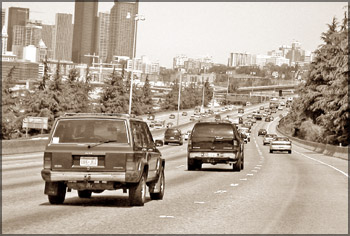Mandatory vehicle emission tests step in right direction
Towards a pollution-free environment:
Ravi LADDUWAHETTY
Belching vehicles on Sri Lankan roads may be well a thing of the past
with the Registrar of Motor Traffic and two private companies - CleanCo
and Laugfs implementing a mandatory vehicle emission test on a Public-
Private sector partnership.
This will also mean that all registered vehicles in Sri Lanka will
have to pass this test mandatorily for them to be eligible for the
revenue license for the ensuing year. This test has also made Sri Lanka
the first South Asian nation to implement such a centralized program.
 The
process is expected to be a role model for Asia with the Regional Head
of the Manila based Division Head of Clean Air Initiative for Asian
Cities Glynda Bathan also visiting Sri Lanka to see the logistics and
the scope of this project. The
process is expected to be a role model for Asia with the Regional Head
of the Manila based Division Head of Clean Air Initiative for Asian
Cities Glynda Bathan also visiting Sri Lanka to see the logistics and
the scope of this project.
Sri Lanka has a vehicle population of 2.4 million of which 50 per
cent of it is in the Western Province but 10% of that also might be non
operational which means that around 1 million vehicles in the Western
Province will have to go through this mandatory test, CleanCo General
Manager Joel Peter told the Daily News.
The project has kicked off full time from Monday November 17 and any
vehicle- be it car, trishaw, motorcycle , lorry, bus or heavy duty
vehicles such as earth moving trucks or container trucks and whatever
vehicle registered with the Registrar of Motor vehicles will have to go
through this mandatory test if the revenue license is to be obtained.
However, the CleanCo/Laufgs infrastructure was ready from July 15 and
has hitherto completed over 3000 tests for vehicle owners who presented
their vehicles, mostly motor cars, on a voluntary basis. This will mean
that the company's fixed stations in the Western Province would be
geared for providing the service.
Peter explained that the most tangible feature of the emission
inspection certificate was that it was tamper proof and has six security
features revolving round the paper and a water mark with serial numbers,
a hologram sticker which means that even if one attempts to duplicate
the paper, it cannot be done due to the hologram sticker.
There is also a bar code and a picture of the vehicle to fortify the
authenticity of the certificate. He said that the vehicles which fail
the initial test also have the option of getting the mistakes corrected
and returning for a new test which is free but the free option will be
limited for the first sixty days.
Mostly the reasons attributable for the failing vehicles is a bad air
filter and spark plugs where all the owner has to do is to maintain the
spark plugs and air filters. However, there may be extreme cases where
the engines will also have to be properly tuned and corrected, he said.
Explaining the operational logistics Operations Manager Surendra
Perera said that there were similarities and differences between the
emission tests for the petrol and the diesel vehicles.
The tests for the diesel vehicles commences with the vehicle being
tested for durability and whether it can stand up to the test. Then, the
second event is the checking of oil temperature by inserting a dip stick
and the oil has to have a minimum of 70 degrees Celsius.
The vehicle should complete a minimum of 15 minutes of warm up for
the combustion to work effectively.
Then the samples of the emission are collected for testing with the
engine running at the Maximum Revolutions Per Minute (RPM). The reports
will show the colour/ opacity and the smoke density which is valued in K
Units and is expected to be a maximum of 8 units. That is the standard
and that level and beyond is a Gross Polluter.
In the case of petrol vehicles, they are tested in two forms. The
first is testing the emissions at a low idle position (with the gear at
neutral which is usually at 800- 1200 RPM) and then at High Idle
Position of 2200-2800 RPM. The testing of the petrol vehicles takes a
maximum of five minutes.
Petrol vehicles have two tests. The first is the Hydro Carbon test
and the other is the Carbon Monoxide (CO). Petrol vehicles (other than
motor cycles and trishaws) are expected to have less than 1200 Hydro
Carbon Parts Per Million (PPM) by volume while for trishaws and motor
cycles are expected to be less than 9000 PPM.
The Carbon Monoxide content is expected to be less than 4.5 per cent
by volume for petrol vehicles other than motor cycles and trishaws while
for motor cycles and trishaws, the limit is 6 per cent by volume. |

